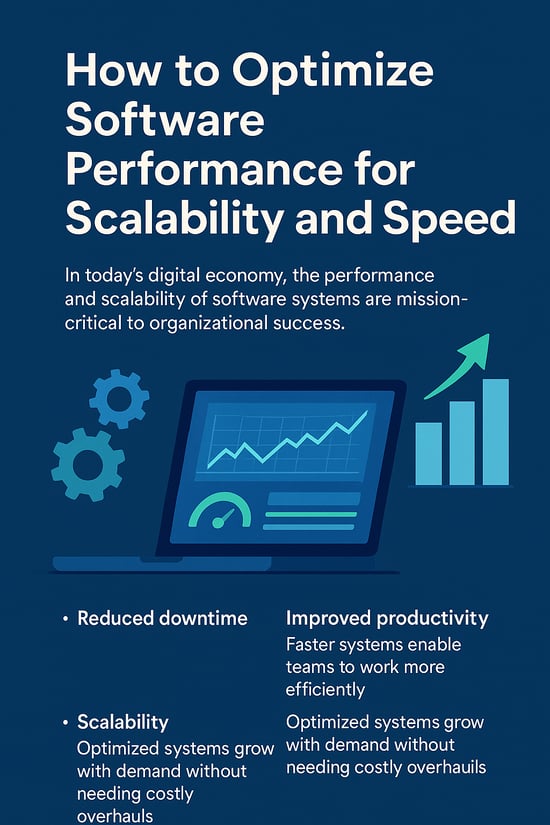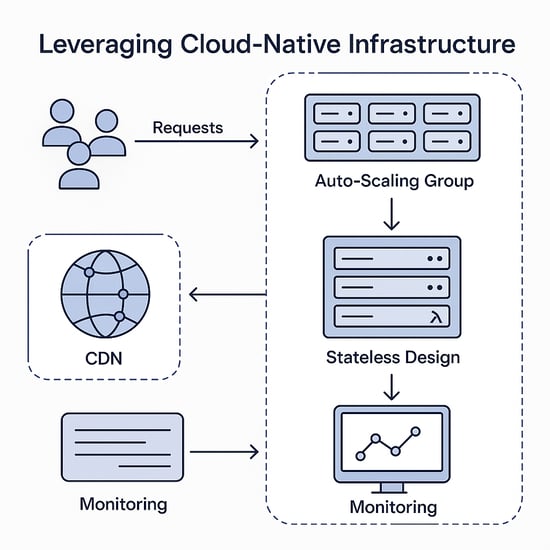How to Optimize Software Performance for Scalability and Speed
In today’s digital economy, the performance and scalability of software systems are mission critical to organizational success. Whether serving citizens through e-government platforms or supporting business operations at scale, software that is fast, responsive, and reliable is no longer a luxury, it’s a necessity. Users expect seamless, real-time experiences, and when systems underperform, they lose trust and patience.
At ICM Solutions, we specialize in building and optimizing high performing software that scales effortlessly and runs efficiently. This whitepaper outlines the importance of performance optimization, key strategies for achieving it, and how our team can help public and private organizations succeed in a high-demand technology environment.

Why Performance Optimization Matters
Slow, unresponsive software creates frustration, disrupts workflows, and increases the likelihood that users will turn to faster alternatives. Google research reveals that 53% of mobile site visitors abandon a page if it takes more than 3 seconds to load¹. That friction has measurable business consequences: Walmart reported a 2% increase in conversions for every 1 second improvement in load time².
From a government perspective, system slowdowns can erode public confidence and cause critical delays. Whether it’s a tax submission platform or a permit application portal, sluggish systems discourage adoption and hurt service delivery outcomes.
Beyond user satisfaction, performance optimization delivers key operational benefits:
- Reduced downtime: Gartner estimates IT downtime costs an average of $5,600 per minute³.
- Improved productivity: Faster systems enable teams to work more efficiently.
- Scalability: Optimized systems grow with demand without needing costly overhauls.
In short, software that performs well enhances user trust, protects against disruption, and supports long-term growth. As McKinsey notes, “Organizations that provide lightning fast digital experiences see a significant competitive advantage in customer satisfaction and operational efficiency”⁴.
Key Strategies for Optimization
1. Efficient Code Design
High performing applications start with efficient, modular code. Well structured code minimizes CPU cycles, memory usage, and input/output operations. A single inefficient algorithm can significantly degrade overall application performance.
Key techniques include:
- Avoiding redundant operations through reusable functions (DRY principle)
- Using appropriate data structures to reduce algorithmic complexity
- Minimizing synchronous blocking operations (e.g., waiting for I/O)
Clean code also supports easier maintenance and faster debugging. According to the IEEE, improving code quality can reduce technical debt and improve team velocity over time⁵.
Modern architectural patterns such as microservices also enhance performance. By breaking monolithic systems into smaller, loosely coupled services, you can optimize and scale parts of the application independently⁶.
2. Load and Stress Testing
Knowing how your system behaves under pressure is essential. Load testing simulates real world user traffic to identify performance bottlenecks, while stress testing determines the system’s breaking point.
Types of performance testing include:
- Load Testing: Simulates expected peak usage.
- Stress Testing: Pushes the system beyond normal limits to test resilience.
- Soak Testing: Evaluates performance over extended periods.
Tools like JMeter, Gatling, and LoadRunner are commonly used to run tests across APIs, databases, and full-stack systems.
According to McKinsey, only 40% of companies have automated performance testing integrated into their DevOps pipelines⁷, an opportunity for major improvement. Regular testing ensures that as usage scales or features evolve, performance remains stable.
3. Database Optimization
Databases often become the primary bottleneck in software systems. Query latency, poorly indexed fields, and bloated datasets can lead to slow response times and even downtime under load.
Optimization strategies include:
- Indexing: Significantly speeds up data retrieval by reducing scan time.
- Query tuning: Refactoring inefficient SQL statements.
- Caching: Storing frequently requested data in memory to reduce load.
- Denormalization (in some use cases): Reduces the need for expensive joins.
In a benchmark study, optimized indexing reduced average query execution time by over 90% in enterprise systems⁸. Tools like PostgreSQL’s EXPLAIN ANALYZE or MySQL’s EXPLAIN help developers visualize query plans and identify performance hotspots.
In memory stores like Redis or Memcached allow applications to offload read heavy operations from the database entirely. Amazon Web Services (AWS) recommends caching as a top tier strategy to reduce latency and cost in cloud environments⁹.
4. Leveraging Cloud-Native Infrastructure
Scalability is one of the key advantages of modern cloud platforms. Cloud-native design allows organizations to dynamically scale infrastructure up or down based on demand, ensuring consistent performance without overprovisioning.
Key practices include:
- Auto-scaling groups: Automatically add compute resources during traffic spikes.
- Stateless design: Enable workload distribution without maintaining persistent sessions.
- Serverless architectures: Use AWS Lambda, Azure Functions, or Google Cloud Functions to scale infinitely without managing servers.
- CDNs (Content Delivery Networks): Distribute static assets globally to reduce latency.
For example, Amazon CloudFront enables content delivery from edge locations worldwide, which can improve page load speeds by over 50% for global users¹⁰.
Gartner predicts that by 2026, over 50% of enterprise cloud workloads will use dynamic performance optimization tools, up from less than 20% in 2022¹¹. This shift reflects the growing understanding that cloud cost efficiency is directly tied to performance optimization.
At ICM Solutions, we help clients design cloud architectures that meet performance needs today and scale to meet future demand.

5. Continuous Monitoring and Observability
Performance optimization is not a one time effort, it requires continuous monitoring. Real-time telemetry data helps teams detect and resolve issues before they impact users.
Monitoring practices include:
- Application Performance Monitoring (APM): Tools like New Relic, Datadog, or Dynatrace track performance metrics in real time.
- Log aggregation and analysis: Platforms like ELK Stack and Splunk consolidate logs for root cause analysis.
- Synthetic monitoring: Simulate user interactions to identify bottlenecks proactively.
- Real User Monitoring (RUM): Tracks actual user behavior across geographies and devices.
According to Gartner, the use of observability platforms that integrate AIOps will grow rapidly in the next three years, driven by the complexity of modern multi-cloud and microservices environments¹².
ICM Solutions builds tailored observability stacks that integrate with CI/CD pipelines, alert on performance regressions, and support rapid root cause resolution.
Case Studies from ICM Solutions
Government Services Portal (U.S. State Agency)
A state government engaged ICM Solutions to improve the performance of its online permitting system. The platform experienced latency issues during quarterly traffic surges, particularly during tax and licensing seasons.
Our solution:
- Refactored legacy .NET codebase to modular microservices
- Introduced Redis caching for form data and session storage
- Conducted stress testing with 100,000+ concurrent users
- Migrated from on-premise hosting to AWS with auto-scaling
Results:
- Reduced average page load time from 5.2 seconds to 1.4 seconds
- Enabled 4x user capacity with no increase in cost
- 28% increase in user satisfaction scores within 3 months
Procurement System Modernization (Large Enterprise Client)
A Fortune 100 company’s internal procurement system suffered from timeouts and errors during monthly reconciliation. ICM Solutions performed a full-stack performance audit.
Our solution:
- Optimized PostgreSQL queries and introduced materialized views
- Rewrote frontend logic in React to minimize render overhead
- Integrated Datadog APM for visibility into service health
Results:
- Cut database query execution time by 87%
- Eliminated system outages during peak reconciliation
-
Improved employee processing efficiency by 35%
How ICM Solutions Can Help
As a trusted IT consulting partner, ICM Solutions offers:
- Performance audits: In-depth analysis of your architecture, code, and infrastructure.
- Load and scalability testing: Simulate real-world usage conditions with actionable reports.
- Database tuning and refactoring: Query optimization, indexing strategies, and schema redesign.
- Cloud-native architecture consulting: Migrations, cost-performance optimization, and multi-region deployments.
- DevOps and observability: CI/CD integration, APM tooling, and dashboard creation.
Whether you need to prepare for a traffic spike, improve response times, or modernize legacy systems, we bring deep expertise and proven results to the table.
Optimizing software for performance and scalability is no longer optional, it’s a strategic necessity. Whether you're managing a public-sector platform or enterprise SaaS product, performance affects everything from user trust to operational efficiency.
The payoff is clear:
- Faster systems = happier users
- Scalable systems = readiness for growth
- Monitored systems = fewer surprises
At ICM Solutions, we provide the tools, techniques, and talent to ensure your software operates at peak performance, even under peak load.
Let’s build software that performs under any load.
Contact us today to learn more.
Sources
- Google Developers. Why Site Speed Matters.
- Cloudflare Blog. Why Site Speed Matters.
- Gartner. The Cost of IT Downtime.
- McKinsey Digital. Modernizing Tech Stacks for Better Performance.
- IEEE Software. Improving Software Quality through Code Optimization.
- Microsoft Azure Architecture Center. Microservices Architecture.
- McKinsey & Company. Why Your Performance Testing Isn’t Working.
- DBDesigner. How Indexing Can Improve SQL Performance.
- AWS. Caching Strategies for Modern Applications.
- Amazon CloudFront. Accelerating Content Delivery.
- Gartner. Cloud Optimization Trends 2024.
- Gartner. Market Guide for AIOps Platforms.

